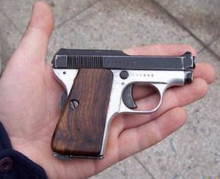Beretta 418

The Beretta 418 in 6.35 mm (.25 ACP) is an easily concealed Italian "pocket pistol". The earliest examples were made between 1919 and 1922. There are several versions, including the 1920 (V1 & V2), 1926, 1926 - 31 (V1 & V2), 1934, 318, and 418 models.
Uncertainty surrounds which year Beretta began producing their first 6.35 calibre pocket pistols. Dates suggested by various sources range between 1919 and 1922, but it is possible that design work for the guns started before the First World War. The exigencies of wartime demanded that precedence be given to military needs. Work on the little 6.35 mm was resumed only at the end of the conflict. The first version of the gun was very similar to the Model 1922; nearly a scale model in fact, with the single important innovation of a spring-loaded firing pin rather than an internal hammer. Mechanically this change was detrimental; it was probably made due to considerations of size. In every other way the two pistols are identical. They share the trigger mechanism fitted with an escaping disconnector, which is typical of all Beretta pistols of that period. A short time afterwards a second version (Model 19) appeared, with an automatic grip safety fitted on the frame backstrap. Presumably the safety was added make up for the reduced level of safety inherent in guns with a striker-type firing pin.
In 1926 a third version of the 6.35 calibre pocket pistol was introduced, in which the firing mechanism was completely redesigned, to incorporate a disconnector similar to the one used in the Beretta M1923. This simple and economical modification contributed to the fame and commercial success of the pistol. It involved a slight change to the left grip, and can easily be seen without dismantling the gun.
Production of the 6.35 calibre pocket pistols continued from the beginning of the 1920s until the middle of the 1930s before Beretta felt the need for a change (apart from the mechanical alteration in 1926). Towards 1935, however, the appearance of the pistol was deemed outdated, and the design of the handgrip changed to be similar to that of the Beretta Model 1934. Later a cocking indicator was also introduced. It consisted of an extension to the firing pin which extended from the back of the slide when in the cocked position. Otherwise the so-called small Berettas remained more or less unchanged in that most of the essential parts - barrel, magazine, etc., - are interchangeable. While changes to the gun during this time were minimal the name was changed often. These various model numbers can be found only in the Beretta catalogues. All the guns manufactured up to the mid-1930s are marked simply IBREV. 1919, and subsequent models until the end of the war are marked Brevettata, with no further details. Similar guns produced immediately after the war can be marked Brevettata, but more often use the abbreviation.
The 418 was a very successful gun, and remained in production until the middle of the 1950s, overlapping with the production of more sophisticated guns Beretta had developed in the meantime. Towards the end of the 1940s a frame in light alloy was also developed. Slight aesthetic modifications were also added shortly afterwards.[1]
The 418 is also known as the favourite pistol of James Bond, up until the novel Dr. No in 1958, when it was replaced by the Walther PPK. In the James Bond novels his Beretta is described as having a skeleton grip (i.e. grips removed - frame only), and a sawn-off barrel.
Capacity
- 4 rounds

